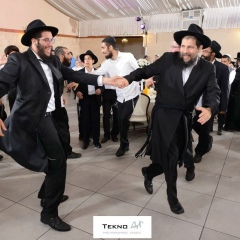Тания 14 ава
Святое послание
Глава 5
Обратимся к словам Алтер Ребе в этом послании:
אַךְ הָאוֹתִיּוֹת הֵן בִּבְחִינַת חֹמֶר וְצוּרָה,
Однако буквы делятся на два аспекта: «хомер» [«материал»] и «цура» [«форма»].
Звуки, составляющие человеческую речь, как уже было сказано, исходят из категории Хохма. Все они созданы из одного материала («хомер»): воздуха, проходящего через речевой аппарат («эвель»), — однако каждый из них обладает индивидуальностью («цура»), которую сообщают ему органы речи, участвующие в его образовании; на письме индивидуальность проявляется в начертании буквы, соответствующей этому звуку.
הַנִּקְרָא פְּנִימִית וְחִיצוֹנִית,
Они называются «пнимиют» [внутренняя сущность] и «хицониют» [внешний аспект]
Говоря о том, из какого материала создан звук, мы указываем на внешний аспект его природы, в то время как индивидуальность звука — его внутренняя суть. Таким образом «хомер» — это «хицониют», внешний аспект, т. е. тот материал, из которого буква состоит, а «цура» — это «пнимиют», внутренняя индивидуальность, «форма», т.е. та духовность, которая формирует индивидуальность каждой буквы.
[Любопытно, что в русском языке понятия «форма» («цура») и «содержание» («хомер») имеют прямо противоположное значение — «содержание» указывает на «внутреннее содержание» вещи, а «форма» указывает на «внешнюю форму» — примечание переводчика (М. Гоцель).]
כִּי הֲגַם שֶׁמְּקוֹרָן הוּא מִקַּדְמוּת הַשֵּׂכֶל וּרְצוֹן הַנֶּפֶשׁ,
И хотя первоисточник звуков — те пласты души, где только формируются мышление и воля, —
Речь идет о категории «Кадмут а-сехель» — это аспект Хохма, который выше Разума. Также категория «Рацон», из которой исходит желание произнести ту или иную букву, источник индивидуальной «формы» буквы.
זוֹ הִיא בְּחִינַת צוּרַת שִׁנּוּי הַמִּבְטָא שֶׁבְּעֱשְׂרִים וּשְׁתַיִם אוֹתִיּוֹת,
в них-то и коренится индивидуальность каждого из звуков, которым соответствуют на письме двадцать две буквы [святого языка Торы].
В момент произношения, когда от букве к букве происходит изменение формы обработки голоса.
אֲבָל בְּחִינַת הַחֹמֶר וְגוּף הִתְהַוּוּתָן, וְהוּא בְּחִינַת חִיצוֹנִיּוּתָן, הוּא הַהֶבֶל הַיּוֹצֵא מֵהַלֵּב,
Материя же [«хомер»], из которой состоит звук, его «плоть», необходимая для того, чтобы он был услышан, категория «хицониют» [внешнего аспекта], возникает при участии особой эманации [«эвель»], исходящей из сердца.
שֶׁמִּמֶּנּוּ מִתְהַוֶּה קוֹל פָּשׁוּט הַיּוֹצֵא מֵהַגָּרוֹן,
Оттуда происходит простой голос, исходящий из гортани
Эта эманация участвует в образовании воздушной струи; когда та проходит через горло, рождается звук, лишенный пока индивидуальности («коль пашут»).
וְאַחַר כָּךְ נֶחֱלָק לְעֱשְׂרִים וְשְׁתַיִם הֲבָרוֹת, וּבִטּוּי עֱשְׂרִים וְשְׁתַיִם אוֹתִיּוֹת
Потом этот звук, обретая ее, принимает форму определенного звукоизвлечения, которому соответствует на письме одна из двадцати двух букв [святого языка Торы].
בָּה' מוּצָאוֹת הַיְּדוּעוֹת
При помощи известных пяти способах звукоизвлечения.
Это разделение происходит, когда струя воздуха проходит через речевой аппарат и начинают работать органы речи, с помощью которых мысль облекается в слова.
אחה"ע מֵהַגָּרוֹן,
АХАА из гортани
В образовании звуков, выражающихся на письме буквами «алеф», «хет», «хей» и «айн», участвует гортань;
גיכ"ק מֵהַחֵךְ כוּ'.
ГИХАК из неба и т. д.
В образовании звуков, которым соответствуют буквы «гимел», «йод», «каф», «коф», — участвует нёбо. В образовании звуков БОМП, которым соответствуют буквы «бейт», «вав», «мем», «пей», — участвуют губы и так далее.
וּמִבְטָא הַהֶבֶל הוּא אוֹת ה' "אָתָא קַלִּילָא כוּ'",
Выдох [«эвель»] выражается буквой Хей, названной «Ата клила» [«легкой буквой»].
Самый же «легкий» звук из всех — тот, которому соответствует буква «хей»: он почти неотличим от шума, который возникает при выдохе. Таким образом, даже сам по себе поток воздуха «эвель», который не используется для образования звука, тем не менее имеет свою «форму» («цура»), определяемую слухом, она выражается буквой Хей. Она называется «легкой» букой поскольку у нее нет осязаемого выражения, подобно другим буквам.
וְהוּא מְקוֹר הַחֹמֶר וְגוּף הָאוֹתִיּוֹת טֶרֶם הִתְחַלְּקוּתָן לְעֱשְׂרִים וּשְׁתַיִם.
Таким образом, этот звук ближе всего к первоисточнику речи, где формируется ее материя [«хомер»], «плоть»; где она еще не разделена на звуки, которым соответствуют на письме двадцать две буквы.
Буква Хей представляет собой источник «плоти» букв.
וְלָכֵן אָמְרוּ רַבֹּותֵינוּ זִכְרֹונָם לִבְרָכָה, שֶׁעוֹלָם הַזֶּה נִבְרָא בָּה':
Потому-то и сказали наши учители, благословенна их память, что физический мир создан силой, заключенной в букве «хей».
Которая дважды встречается в четырехбуквенном имени Всевышнего и выражает самый внешний, близкий к материальному миру, аспект речений Творца. Понятно, что имеются в виду не графические изображения букв, а те духовные сущности, которые они воплощают.
Святое послание
Глава 5
Обратимся к словам Алтер Ребе в этом послании:
אַךְ הָאוֹתִיּוֹת הֵן בִּבְחִינַת חֹמֶר וְצוּרָה,
Однако буквы делятся на два аспекта: «хомер» [«материал»] и «цура» [«форма»].
Звуки, составляющие человеческую речь, как уже было сказано, исходят из категории Хохма. Все они созданы из одного материала («хомер»): воздуха, проходящего через речевой аппарат («эвель»), — однако каждый из них обладает индивидуальностью («цура»), которую сообщают ему органы речи, участвующие в его образовании; на письме индивидуальность проявляется в начертании буквы, соответствующей этому звуку.
הַנִּקְרָא פְּנִימִית וְחִיצוֹנִית,
Они называются «пнимиют» [внутренняя сущность] и «хицониют» [внешний аспект]
Говоря о том, из какого материала создан звук, мы указываем на внешний аспект его природы, в то время как индивидуальность звука — его внутренняя суть. Таким образом «хомер» — это «хицониют», внешний аспект, т. е. тот материал, из которого буква состоит, а «цура» — это «пнимиют», внутренняя индивидуальность, «форма», т.е. та духовность, которая формирует индивидуальность каждой буквы.
[Любопытно, что в русском языке понятия «форма» («цура») и «содержание» («хомер») имеют прямо противоположное значение — «содержание» указывает на «внутреннее содержание» вещи, а «форма» указывает на «внешнюю форму» — примечание переводчика (М. Гоцель).]
כִּי הֲגַם שֶׁמְּקוֹרָן הוּא מִקַּדְמוּת הַשֵּׂכֶל וּרְצוֹן הַנֶּפֶשׁ,
И хотя первоисточник звуков — те пласты души, где только формируются мышление и воля, —
Речь идет о категории «Кадмут а-сехель» — это аспект Хохма, который выше Разума. Также категория «Рацон», из которой исходит желание произнести ту или иную букву, источник индивидуальной «формы» буквы.
זוֹ הִיא בְּחִינַת צוּרַת שִׁנּוּי הַמִּבְטָא שֶׁבְּעֱשְׂרִים וּשְׁתַיִם אוֹתִיּוֹת,
в них-то и коренится индивидуальность каждого из звуков, которым соответствуют на письме двадцать две буквы [святого языка Торы].
В момент произношения, когда от букве к букве происходит изменение формы обработки голоса.
אֲבָל בְּחִינַת הַחֹמֶר וְגוּף הִתְהַוּוּתָן, וְהוּא בְּחִינַת חִיצוֹנִיּוּתָן, הוּא הַהֶבֶל הַיּוֹצֵא מֵהַלֵּב,
Материя же [«хомер»], из которой состоит звук, его «плоть», необходимая для того, чтобы он был услышан, категория «хицониют» [внешнего аспекта], возникает при участии особой эманации [«эвель»], исходящей из сердца.
שֶׁמִּמֶּנּוּ מִתְהַוֶּה קוֹל פָּשׁוּט הַיּוֹצֵא מֵהַגָּרוֹן,
Оттуда происходит простой голос, исходящий из гортани
Эта эманация участвует в образовании воздушной струи; когда та проходит через горло, рождается звук, лишенный пока индивидуальности («коль пашут»).
וְאַחַר כָּךְ נֶחֱלָק לְעֱשְׂרִים וְשְׁתַיִם הֲבָרוֹת, וּבִטּוּי עֱשְׂרִים וְשְׁתַיִם אוֹתִיּוֹת
Потом этот звук, обретая ее, принимает форму определенного звукоизвлечения, которому соответствует на письме одна из двадцати двух букв [святого языка Торы].
בָּה' מוּצָאוֹת הַיְּדוּעוֹת
При помощи известных пяти способах звукоизвлечения.
Это разделение происходит, когда струя воздуха проходит через речевой аппарат и начинают работать органы речи, с помощью которых мысль облекается в слова.
אחה"ע מֵהַגָּרוֹן,
АХАА из гортани
В образовании звуков, выражающихся на письме буквами «алеф», «хет», «хей» и «айн», участвует гортань;
גיכ"ק מֵהַחֵךְ כוּ'.
ГИХАК из неба и т. д.
В образовании звуков, которым соответствуют буквы «гимел», «йод», «каф», «коф», — участвует нёбо. В образовании звуков БОМП, которым соответствуют буквы «бейт», «вав», «мем», «пей», — участвуют губы и так далее.
וּמִבְטָא הַהֶבֶל הוּא אוֹת ה' "אָתָא קַלִּילָא כוּ'",
Выдох [«эвель»] выражается буквой Хей, названной «Ата клила» [«легкой буквой»].
Самый же «легкий» звук из всех — тот, которому соответствует буква «хей»: он почти неотличим от шума, который возникает при выдохе. Таким образом, даже сам по себе поток воздуха «эвель», который не используется для образования звука, тем не менее имеет свою «форму» («цура»), определяемую слухом, она выражается буквой Хей. Она называется «легкой» букой поскольку у нее нет осязаемого выражения, подобно другим буквам.
וְהוּא מְקוֹר הַחֹמֶר וְגוּף הָאוֹתִיּוֹת טֶרֶם הִתְחַלְּקוּתָן לְעֱשְׂרִים וּשְׁתַיִם.
Таким образом, этот звук ближе всего к первоисточнику речи, где формируется ее материя [«хомер»], «плоть»; где она еще не разделена на звуки, которым соответствуют на письме двадцать две буквы.
Буква Хей представляет собой источник «плоти» букв.
וְלָכֵן אָמְרוּ רַבֹּותֵינוּ זִכְרֹונָם לִבְרָכָה, שֶׁעוֹלָם הַזֶּה נִבְרָא בָּה':
Потому-то и сказали наши учители, благословенна их память, что физический мир создан силой, заключенной в букве «хей».
Которая дважды встречается в четырехбуквенном имени Всевышнего и выражает самый внешний, близкий к материальному миру, аспект речений Творца. Понятно, что имеются в виду не графические изображения букв, а те духовные сущности, которые они воплощают.
Tania 14 ave
Holy message
Chapter 5
We turn to the words of Alter Rebbe in this message:
אַךְ הָאוֹתִיּוֹת הֵן בִּבְחִינַת חֹמֶר וְצוּרָה,
However, the letters are divided into two aspects: “homer” [“material”] and “tsur” [“form”].
The sounds that make up human speech, as already mentioned, come from the category of Hochma. All of them are created from the same material (“homer”): air passing through the speech apparatus (“evel”), but each of them has an individuality (“tsur”), which the speech organs involved in its formation inform him of; in a letter, individuality is manifested in the writing of a letter corresponding to this sound.
הַנִּקְרָא פְּנִימִית וְחִיצוֹנִית,
They are called “Pnimyut” [internal essence] and “Hitsoniut” [external aspect]
Speaking of what material the sound is made of, we indicate the external aspect of its nature, while the individuality of sound is its internal essence. Thus, a “homer” is a “hitsonut”, an external aspect, that is, the material of which the letter consists, and a “tsur” is a “pnimyut”, an internal individuality, a “form”, i.e. the spirituality that forms the individuality of each letter.
[It is curious that in Russian the concepts of “form” (“tsur”) and “content” (“homer”) have exactly the opposite meaning - “content” indicates the “internal content” of a thing, and “form” indicates a “external form "- note by the translator (M. Gocel).]
כִּי הֲגַם שֶׁמְּקוֹרָן הוּא מִקַּדְמוּת הַשֵּׂכֶל וּרְצוֹן הַנֶּפֶשׁ,
And although the primary source of sounds is those strata of the soul where thought and will only form,
We are talking about the category “Kadmut a-Sekhel” - this is an aspect of Hochma that is higher than Reason. Also, the category "Ratson", from which comes the desire to pronounce this or that letter, is the source of the individual "form" of the letter.
זוֹ הִיא בְּחִינַת צוּרַת שִׁנּוּי הַמִּבְטָא שֶׁבְּעֱשְׂרִים וּשְׁתַיִם אוֹתִיּוֹת,
it is in them that the individuality of each sound is rooted, which correspond to twenty-two letters in the letter [the holy language of the Torah].
At the time of pronunciation, when from letter to letter there is a change in the form of voice processing.
אֲבָל בְּחִינַת הַחֹמֶר וְגוּף הִתְהַוּוּתָן, וְהוּא בְּחִינַת חִיצוֹנִיּוּתָן, הוּא הַהֶבֶל הַיּוֹצֵא מֵהַלֵּב,
The matter [the “homer”], from which the sound consists, its “flesh”, which is necessary for it to be heard, the category “hench” (external aspect), arises with the participation of a special emanation [“evel”] coming from the heart .
שֶׁמִּמֶּנּוּ מִתְהַוֶּה קוֹל פָּשׁוּט הַיּוֹצֵא מֵהַגָּרוֹן,
From there comes a simple voice coming from the larynx
This emanation is involved in the formation of an air stream; when it passes through the throat, a sound is born, devoid of individuality so far (“plow”).
וְאַחַר כָּךְ נֶחֱלָק לְעֱשְׂרִים וְשְׁתַיִם הֲבָרוֹת, וּבִטּוּי עֱשְׂרִים וְשְׁתַיִם אוֹתִיּוֹת
Then this sound, gaining it, takes the form of a certain sound production, which corresponds to one of twenty-two letters [the holy language of the Torah] in writing.
בָּה 'מוּצָאוֹת הַיְּדוּעוֹת
Using the well-known five methods of sound extraction.
This separation occurs when a stream of air passes through the speech apparatus and the organs of speech begin to work, with the help of which the thought is clothed in words.
אחה"ע מֵהַגָּרוֹן,
AXAA from the larynx
The larynx is involved in the formation of sounds expressed in letters by the letters "Aleph", "Hat", "Hey" and "Ain";
גיכ"ק מֵהַחֵךְ כוּ '.
GIHAK from the sky, etc.
In the formation of sounds, which correspond to the letters "gimel", "iodine", "cafe", "coffee" - the palate is involved. In the formation of BOMP sounds, which correspond to the letters “beit”, “vav”, “meme”, “drink”, lips participate and so on.
וּמִבְטָא הַהֶבֶל הוּא אוֹת ה '"אָתָא קַלִּילָא כוּ'",
The exhalation [“evel”] is expressed by the letter Hey, called “Ata Klila” [“light letter”].
The “lightest” sound of all is the one that corresponds to the letter “hey”: it is almost indistinguishable from the noise that occurs when you exhale. Thus, even the “evel” air flow itself, which is not used to produce sound, nevertheless has its own “form” (“tsur”) defined by hearing, it is expressed by the letter Hey. It is called a “light” beech because it has no tangible expression, like other letters.
וְהוּא מְקוֹר הַחֹמֶר וְגוּף הָאוֹתִיּוֹת טֶרֶם הִתְחַלְּקוּתָן לְעֱשְׂרִים וּשְׁתַיִם.
Thus, this sound is closest to the primary source of speech, where its matter [“homer”], “flesh” is formed; where it is not yet divided into sounds, which correspond to twenty-two letters in a letter.
The letter Hey represents the source of the "flesh" of letters.
וְלָכֵן אָמְרוּ רַבֹּותֵינוּ זִכְרֹונָם לִבְרָכָה, שֶׁעוֹלָם הַזֶּה נִבְרָא בָּה ':
That's why our teachers said, blessed be their memory that the physical world was created by the power enclosed in the letter “hey”.
Which twice occurs in the four-letter name of the Most High and expresses the most external, close to the material world, aspect of the Creator's utterances. It is clear that these are not graphic images of letters, but those spiritual entities that they embody.
Holy message
Chapter 5
We turn to the words of Alter Rebbe in this message:
אַךְ הָאוֹתִיּוֹת הֵן בִּבְחִינַת חֹמֶר וְצוּרָה,
However, the letters are divided into two aspects: “homer” [“material”] and “tsur” [“form”].
The sounds that make up human speech, as already mentioned, come from the category of Hochma. All of them are created from the same material (“homer”): air passing through the speech apparatus (“evel”), but each of them has an individuality (“tsur”), which the speech organs involved in its formation inform him of; in a letter, individuality is manifested in the writing of a letter corresponding to this sound.
הַנִּקְרָא פְּנִימִית וְחִיצוֹנִית,
They are called “Pnimyut” [internal essence] and “Hitsoniut” [external aspect]
Speaking of what material the sound is made of, we indicate the external aspect of its nature, while the individuality of sound is its internal essence. Thus, a “homer” is a “hitsonut”, an external aspect, that is, the material of which the letter consists, and a “tsur” is a “pnimyut”, an internal individuality, a “form”, i.e. the spirituality that forms the individuality of each letter.
[It is curious that in Russian the concepts of “form” (“tsur”) and “content” (“homer”) have exactly the opposite meaning - “content” indicates the “internal content” of a thing, and “form” indicates a “external form "- note by the translator (M. Gocel).]
כִּי הֲגַם שֶׁמְּקוֹרָן הוּא מִקַּדְמוּת הַשֵּׂכֶל וּרְצוֹן הַנֶּפֶשׁ,
And although the primary source of sounds is those strata of the soul where thought and will only form,
We are talking about the category “Kadmut a-Sekhel” - this is an aspect of Hochma that is higher than Reason. Also, the category "Ratson", from which comes the desire to pronounce this or that letter, is the source of the individual "form" of the letter.
זוֹ הִיא בְּחִינַת צוּרַת שִׁנּוּי הַמִּבְטָא שֶׁבְּעֱשְׂרִים וּשְׁתַיִם אוֹתִיּוֹת,
it is in them that the individuality of each sound is rooted, which correspond to twenty-two letters in the letter [the holy language of the Torah].
At the time of pronunciation, when from letter to letter there is a change in the form of voice processing.
אֲבָל בְּחִינַת הַחֹמֶר וְגוּף הִתְהַוּוּתָן, וְהוּא בְּחִינַת חִיצוֹנִיּוּתָן, הוּא הַהֶבֶל הַיּוֹצֵא מֵהַלֵּב,
The matter [the “homer”], from which the sound consists, its “flesh”, which is necessary for it to be heard, the category “hench” (external aspect), arises with the participation of a special emanation [“evel”] coming from the heart .
שֶׁמִּמֶּנּוּ מִתְהַוֶּה קוֹל פָּשׁוּט הַיּוֹצֵא מֵהַגָּרוֹן,
From there comes a simple voice coming from the larynx
This emanation is involved in the formation of an air stream; when it passes through the throat, a sound is born, devoid of individuality so far (“plow”).
וְאַחַר כָּךְ נֶחֱלָק לְעֱשְׂרִים וְשְׁתַיִם הֲבָרוֹת, וּבִטּוּי עֱשְׂרִים וְשְׁתַיִם אוֹתִיּוֹת
Then this sound, gaining it, takes the form of a certain sound production, which corresponds to one of twenty-two letters [the holy language of the Torah] in writing.
בָּה 'מוּצָאוֹת הַיְּדוּעוֹת
Using the well-known five methods of sound extraction.
This separation occurs when a stream of air passes through the speech apparatus and the organs of speech begin to work, with the help of which the thought is clothed in words.
אחה"ע מֵהַגָּרוֹן,
AXAA from the larynx
The larynx is involved in the formation of sounds expressed in letters by the letters "Aleph", "Hat", "Hey" and "Ain";
גיכ"ק מֵהַחֵךְ כוּ '.
GIHAK from the sky, etc.
In the formation of sounds, which correspond to the letters "gimel", "iodine", "cafe", "coffee" - the palate is involved. In the formation of BOMP sounds, which correspond to the letters “beit”, “vav”, “meme”, “drink”, lips participate and so on.
וּמִבְטָא הַהֶבֶל הוּא אוֹת ה '"אָתָא קַלִּילָא כוּ'",
The exhalation [“evel”] is expressed by the letter Hey, called “Ata Klila” [“light letter”].
The “lightest” sound of all is the one that corresponds to the letter “hey”: it is almost indistinguishable from the noise that occurs when you exhale. Thus, even the “evel” air flow itself, which is not used to produce sound, nevertheless has its own “form” (“tsur”) defined by hearing, it is expressed by the letter Hey. It is called a “light” beech because it has no tangible expression, like other letters.
וְהוּא מְקוֹר הַחֹמֶר וְגוּף הָאוֹתִיּוֹת טֶרֶם הִתְחַלְּקוּתָן לְעֱשְׂרִים וּשְׁתַיִם.
Thus, this sound is closest to the primary source of speech, where its matter [“homer”], “flesh” is formed; where it is not yet divided into sounds, which correspond to twenty-two letters in a letter.
The letter Hey represents the source of the "flesh" of letters.
וְלָכֵן אָמְרוּ רַבֹּותֵינוּ זִכְרֹונָם לִבְרָכָה, שֶׁעוֹלָם הַזֶּה נִבְרָא בָּה ':
That's why our teachers said, blessed be their memory that the physical world was created by the power enclosed in the letter “hey”.
Which twice occurs in the four-letter name of the Most High and expresses the most external, close to the material world, aspect of the Creator's utterances. It is clear that these are not graphic images of letters, but those spiritual entities that they embody.
У записи 5 лайков,
0 репостов,
451 просмотров.
0 репостов,
451 просмотров.
Эту запись оставил(а) на своей стене Хаим Толочинский


























